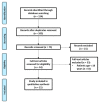Muscle Energy Technique in the Rehabilitative Treatment for Acute and Chronic Non-Specific Neck Pain: A Systematic Review
- PMID: 34204590
- PMCID: PMC8234422
- DOI: 10.3390/healthcare9060746
Muscle Energy Technique in the Rehabilitative Treatment for Acute and Chronic Non-Specific Neck Pain: A Systematic Review
Abstract
Background: Non-specific neck pain (NNP) affects 30-50% of the general population, and it often leads to severe disability. Several manual therapy techniques are available to reduce pain and disability and to improve cervical range of motion and functional activities. Muscle Energy Technique (MET) showed more evidence for treating such a disorder. The aim of this current scientific literature analysis was to compare the clinical effects of MET with the other manual or rehabilitative treatments for non-specific acute and chronic neck pain.
Methods: The literature search was conducted using the following databases: PubMed, Medline, PEDro, Cochrane Database, and Google Scholar from 2010 to January 2020. Clinical trials about MET were included. The quality of the trials was assessed according to the PEDro scale.
Results: Twenty-one papers according to inclusion and exclusion criteria were selected: 15 studies about non-specific acute neck pain and 6 studies about non-specific chronic neck pain.
Conclusions: This analysis suggests that the MET approach has a good clinical effect on reducing neck pain in patients with acute neck pain and improves cervical range of motion in patients with chronic neck pain, and is better if combined with a traditional rehabilitative approach. This review's findings should be considered with caution for physiotherapy practice because of the studies' methodologic limitations. On the basis of the current available and limited evidence, clinicians could combine MET with traditional physiotherapy and other manual techniques when treating people with non-specific neck pain.
Keywords: management; muscle energy technique; neck pain; rehabilitation; systematic review; upper trapezius trigger points.
Conflict of interest statement
The authors declare no conflict of interest.
References
-
- Binder A. The diagnosis and treatment of nonspecific neck pain and whiplash. Eur. Medicophys. 2007;43:79–89. - PubMed
-
- Mangone M., Paoloni M., Procopio S., Venditto T., Zucchi B., Santilli V., Paolucci T., Agostini F., Bernetti A. Sagittal spinal alignment in patients with ankylosing spondylitis by rasterstereographic back shape analysis: An observational retrospective study. Eur. J. Phys. Rehabil. Med. 2020;56:191–196. doi: 10.23736/S1973-9087.20.05993-6. - DOI - PubMed
-
- Murray C.J., Atkinson C., Bhalla K., Birbeck G., Burstein R., Chou D., Dellavalle R., Danaei G., Ezzati M., Fahimi A., et al. U.S. Burden of Disease Collaborators. The state of US health, 1990–2010: Burden of diseases, injuries, and risk factors. JAMA. 2013;310:591–608. doi: 10.1001/jama.2013.13805. - DOI - PMC - PubMed
Publication types
LinkOut - more resources
Full Text Sources
Medical
Miscellaneous


